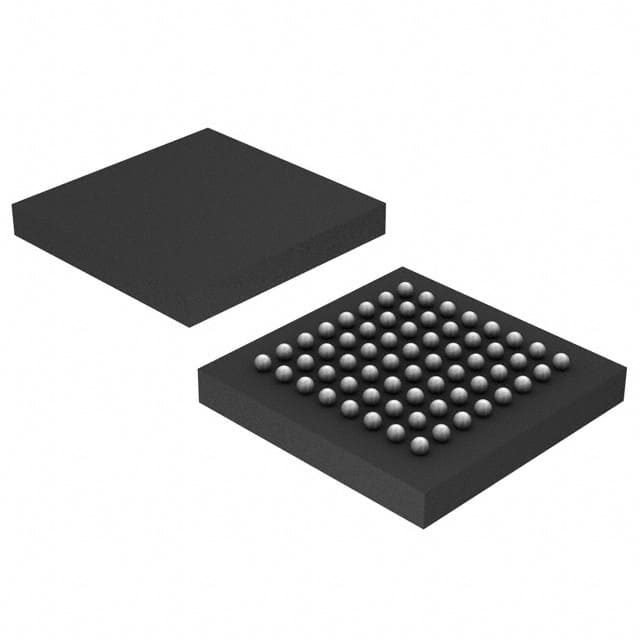ADS1194CZXGR
Product Overview
Category
The ADS1194CZXGR belongs to the category of integrated circuits (ICs) specifically designed for biomedical applications.
Use
This IC is primarily used in medical devices and equipment for measuring and monitoring bioelectric signals, such as electrocardiograms (ECGs).
Characteristics
- High-resolution: The ADS1194CZXGR offers high-resolution data conversion, allowing for accurate measurement and analysis of bioelectric signals.
- Low power consumption: This IC is designed to operate with low power consumption, making it suitable for portable and battery-powered medical devices.
- Noise filtering: It incorporates advanced noise filtering techniques to ensure reliable and clean signal acquisition.
- Flexible packaging options: The ADS1194CZXGR is available in a small form factor package, enabling its integration into compact medical devices.
Package
The ADS1194CZXGR is packaged in a 64-pin BGA (Ball Grid Array) package.
Essence
The essence of the ADS1194CZXGR lies in its ability to acquire and process bioelectric signals accurately and efficiently, facilitating the development of advanced medical devices.
Packaging/Quantity
This IC is typically sold in reels or trays, with a quantity of 250 units per reel/tray.
Specifications
- Resolution: 24 bits
- Sampling Rate: Up to 32 kSPS (samples per second)
- Input Channels: 4 differential channels
- Input Voltage Range: ±2.5 V
- Power Supply Voltage: 2.7 V to 5.25 V
- Operating Temperature Range: -40°C to +85°C
Detailed Pin Configuration
The ADS1194CZXGR features a total of 64 pins, each serving a specific purpose. The pin configuration is as follows:
- AVDD: Analog power supply voltage
- DVDD: Digital power supply voltage
- AGND: Analog ground
- DGND: Digital ground
- CLK: Clock input
- CS: Chip select input
- DRDY: Data ready output
- RESET: Reset input
- START: Start conversion input
- PWDN: Power-down input 11-14. INP1, INN1, INP2, INN2: Differential input channels 1 and 2 15-18. INP3, INN3, INP4, INN4: Differential input channels 3 and 4 19-26. GPIO1-GPIO8: General-purpose I/O pins 27-34. NC: No connection 35-38. REFOUTP, REFOUTN, REFINP, REFINN: Reference voltage inputs and outputs 39-64. NC: No connection
Functional Features
The ADS1194CZXGR offers several functional features that enhance its performance in biomedical applications:
- High-resolution data conversion: The 24-bit resolution ensures accurate measurement of bioelectric signals.
- Low noise amplification: The IC incorporates low-noise amplifiers to minimize signal distortion and interference.
- Programmable gain: It allows for adjustable gain settings to accommodate different signal amplitudes.
- Integrated filters: The built-in filters eliminate unwanted noise and artifacts from the acquired signals.
- Serial interface: The IC supports a serial communication interface for easy integration with microcontrollers or other digital systems.
Advantages and Disadvantages
Advantages
- High-resolution data conversion for precise signal measurement
- Low power consumption, suitable for portable medical devices
- Noise filtering techniques ensure reliable signal acquisition
- Flexible packaging options for compact device integration
Disadvantages
- Limited number of input channels (4)
- Higher cost compared to some alternative models
Working Principles
The ADS1194CZXGR operates based on the principle of analog-to-digital conversion. It receives bioelectric signals from the input channels, amplifies them with low noise amplifiers, and converts them into digital data using a high-resolution ADC (Analog-to-Digital Converter). The acquired digital data can then be processed and analyzed by medical devices or systems.
Detailed Application Field Plans
The ADS1194CZXGR finds applications in various fields related to biomedical signal acquisition and analysis. Some detailed application field plans include:
- Electrocardiography (ECG) devices: The IC is commonly used in ECG devices for accurate measurement and analysis of heart activity.
- Sleep monitoring systems: It can be integrated into sleep monitoring systems to capture and analyze brainwave signals during sleep.
- Exercise physiology equipment: The IC enables precise measurement of muscle activity during exercise, aiding in performance evaluation and rehabilitation.
- Remote patient monitoring: It can be utilized in remote patient monitoring systems to transmit bioelectric signals wirelessly for real-time analysis by healthcare professionals.
Detailed and Complete Alternative Models
While the ADS
قم بإدراج 10 أسئلة وإجابات شائعة تتعلق بتطبيق ADS1194CZXGR في الحلول التقنية
Sure! Here are 10 common questions and answers related to the application of ADS1194CZXGR in technical solutions:
Q: What is ADS1194CZXGR? A: ADS1194CZXGR is a high-performance, low-power, four-channel analog front-end (AFE) for biopotential measurements.
Q: What are the key features of ADS1194CZXGR? A: Some key features include low noise, high input impedance, programmable gain, integrated filters, and flexible data rates.
Q: What applications can ADS1194CZXGR be used for? A: ADS1194CZXGR is commonly used in applications such as electrocardiography (ECG), electromyography (EMG), and electroencephalography (EEG).
Q: How many channels does ADS1194CZXGR support? A: ADS1194CZXGR supports four channels, allowing simultaneous measurement of multiple biopotential signals.
Q: What is the power consumption of ADS1194CZXGR? A: ADS1194CZXGR has low power consumption, typically operating at less than 1mW per channel.
Q: Can ADS1194CZXGR interface with microcontrollers or processors? A: Yes, ADS1194CZXGR can interface with various microcontrollers or processors through standard communication interfaces like SPI or I2C.
Q: Does ADS1194CZXGR have built-in filters? A: Yes, ADS1194CZXGR has programmable digital filters that can be configured to remove unwanted noise and interference.
Q: What is the input voltage range of ADS1194CZXGR? A: The input voltage range of ADS1194CZXGR is typically ±4.5V, allowing for the measurement of a wide range of biopotential signals.
Q: Can ADS1194CZXGR operate in battery-powered devices? A: Yes, ADS1194CZXGR has low power requirements and can be used in battery-powered devices, making it suitable for portable applications.
Q: Are evaluation modules or reference designs available for ADS1194CZXGR? A: Yes, Texas Instruments provides evaluation modules and reference designs that help developers quickly prototype and integrate ADS1194CZXGR into their systems.
Please note that these answers are general and may vary depending on specific implementation details and requirements.


